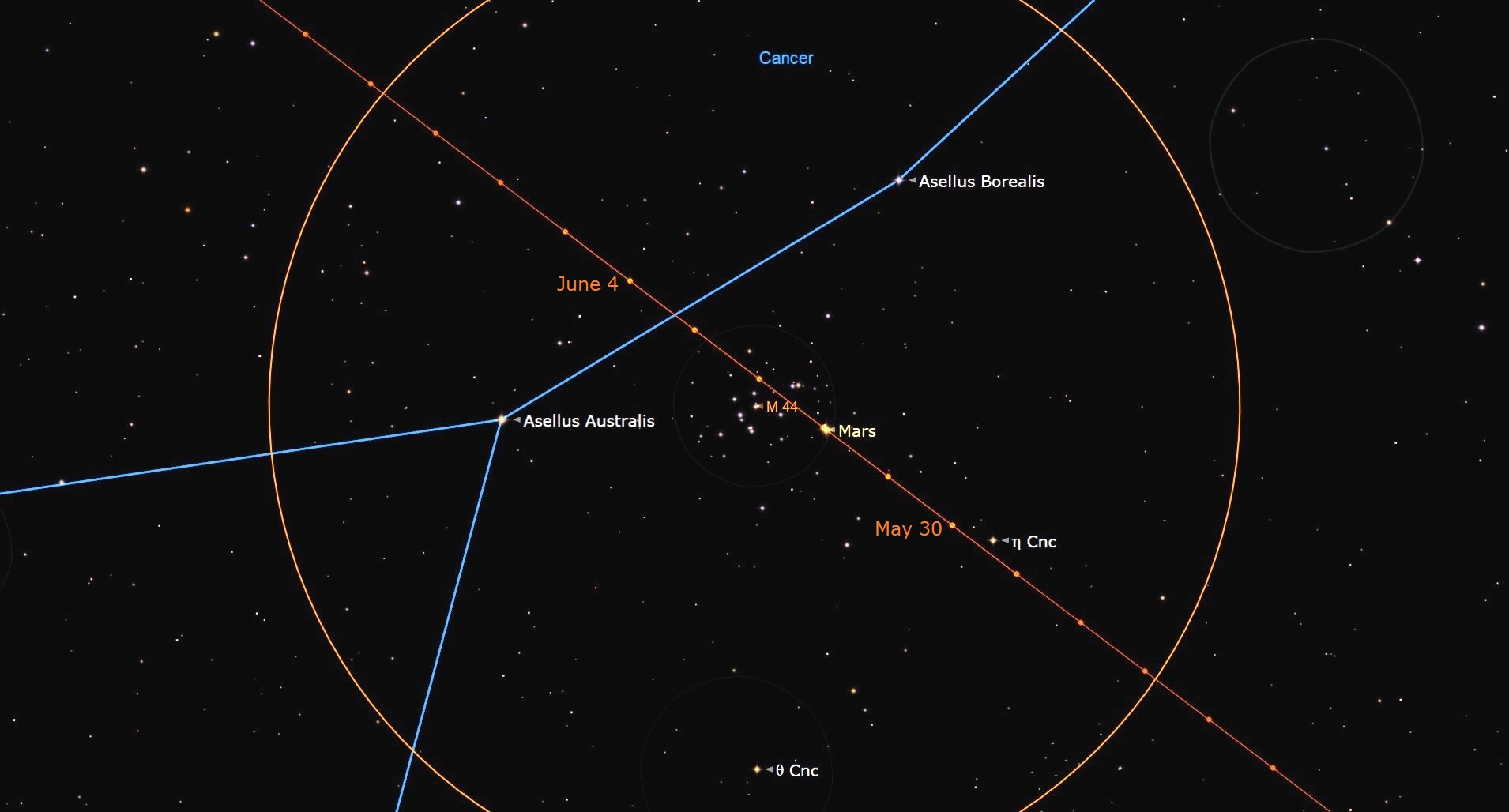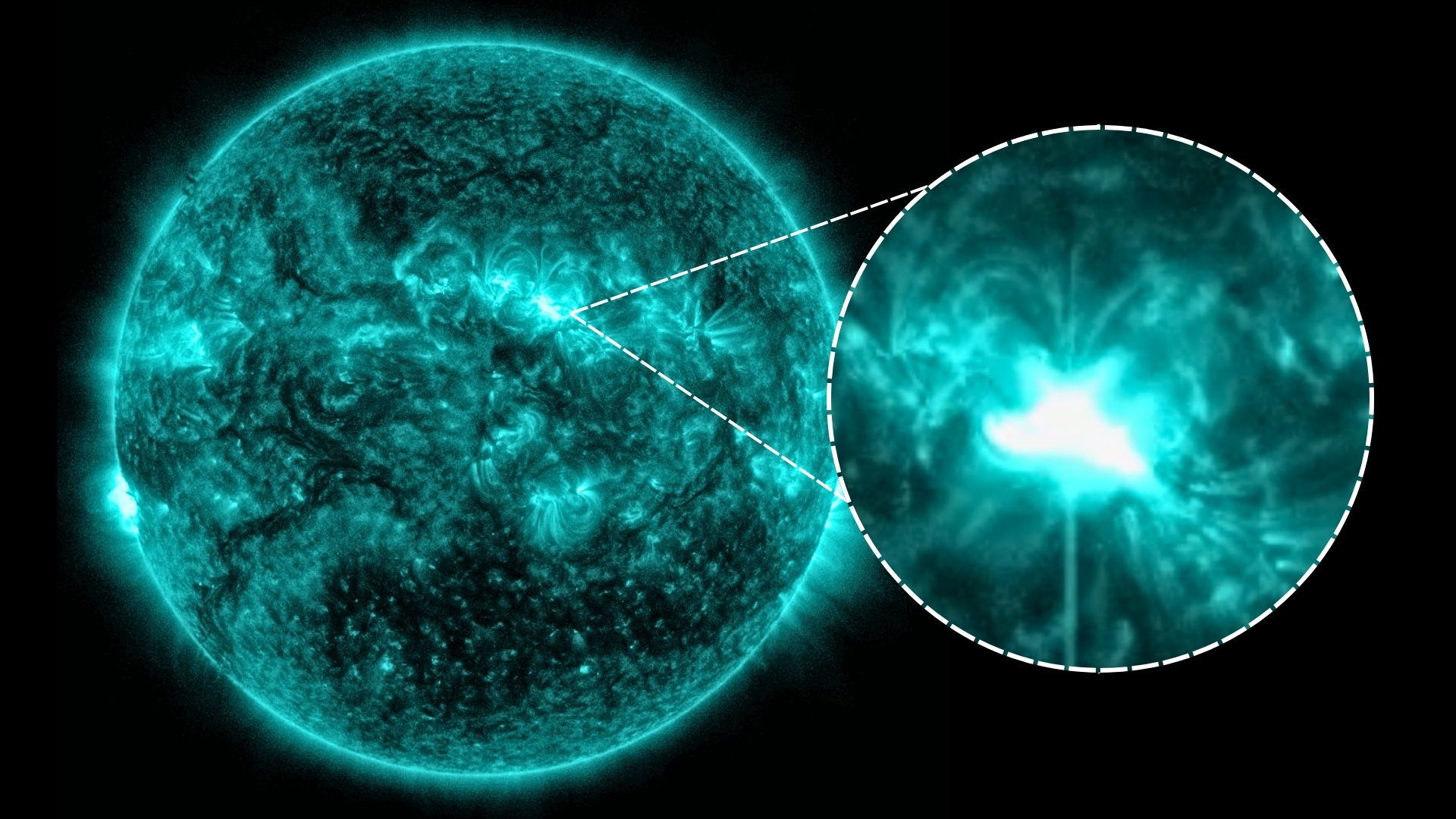See Mars buzz the dense stars of the Beehive Cluster tonight
The Red Planet will be in the midst of the densely-packed stars of the Beehive Cluster, also known as Messier 44.

Mars is sweeping right into the middle of a starry cosmic beehive that outshines its dim constellation of Cancer, the Crab tonight.
The Beehive Cluster (referred to officially as Messier 44 or M44), is a swarm of at least 1,000 loosely bound stars about 600 light-years from Earth. This cluster will receive a visit from the Red Planet on Friday (June 2), offering a great opportunity for skywatchers and astrophotographers alike.
Mars is now crossing the Beehive Cluster and will be closest to its center at nightfall tonight (June 2). From New York City, the duo will be visible at 9:15 p.m. ET (0115 GMT) when it reaches an altitude of 30 degrees above the horizon to the west, according to In The Sky. (For reference, the width of your fist held out at arm's length corresponds to about ten degrees in the sky.) Both Mars and the Beehive Cluster will set at 12:07 a.m. ET on June 3 (0407 GMT), which is about three hours and 46 minutes after sunset. By the time Saturday evening (June 3) rolls in, Mars will have moved past the cluster's boundaries.
If conditions aren't right in your area to see this spectacle tonight, no need to worry: The Virtual Telescope Project will a host a free telescope livestream of Mars and the Beehive Cluster beginning at 4 p.m. ET (2000 GMT). Watch it here courtesy of the Project.
Related: Night sky, June 2023: What you can see tonight [maps]

Want to get a good look at Mars or the Beehive Cluster in the night sky? We recommend the Celestron Astro Fi 102as the top pick in our best beginner's telescope guide.
The Beehive Cluster, whose stars are only 600 million years old, is the nearest such open cluster to Earth and spans 1.6 degrees in the night sky, about the width of three full moons.
With an unaided eye, the cluster is seen as a faint cloud or a celestial mist, which is how French astronomer Charles Messier described it in his famous 18th century catalog of 110 unusual deep-sky objects — one of which is M44.
Breaking space news, the latest updates on rocket launches, skywatching events and more!
In 2012, NASA's now-retired Kepler Space Telescope had for the first time found two Jupiter-like planets closely orbiting sun-like stars in the Beehive Cluster. Among other potential planets that Kepler had cataloged while observing the cluster, astronomers confirmed the identity of six additional planets in 2016.
Tonight, the Beehive Cluster shines at a magnitude of 3.1 and will be a speckled background for Mars's visit, which at magnitude 1.6 will be sailing through the cluster as a brighter orange-red dot in the night sky.
Binocular-equipped stargazers can resolve up to 20 stars of the young Beehive Cluster, while a telescope will be able to get hundreds more into focus, according to Binoculars Sky.
If you are hoping to catch a look at Mars or the Beehive Cluster up close, our guides to the best telescopes and best binoculars are a great place to start.
And you're looking to snap photos of this event or the night sky in general, check out our guide on how to photograph the planets, as well as our best cameras for astrophotography and best lenses for astrophotography.
Editor's Note: If you snap an image of Mars in the Beehive Cluster and would like to share it with Space.com's readers, send your photo(s), comments, and your name and location to spacephotos@space.com.
Join our Space Forums to keep talking space on the latest missions, night sky and more! And if you have a news tip, correction or comment, let us know at: community@space.com.

Sharmila Kuthunur is a Seattle-based science journalist focusing on astronomy and space exploration. Her work has also appeared in Scientific American, Astronomy and Live Science, among other publications. She has earned a master's degree in journalism from Northeastern University in Boston. Follow her on BlueSky @skuthunur.bsky.social
-
rod I did enjoy some of this sky show last evening.Reply
Observed 2000-2130 EDT. Sunset near 2026 EDT, Moon waxing gibbous in Libra, Full Moon 04-June-2023 0342 UT. I used 10x50 binoculars and my 90-mm refractor telescope. Mars passing through M44 in Cancer, Venus in Gemini. Mars and M44 angular separation about 0.5-degrees or just less than 32 arcminutes in the sky as Mars passes through M44. Both Mars and M44 fit into the FOV at 25x, 71x, and 111x. The TeleVue 14-mm Delos at 71x provided a very nice view of the pair and the TeleVue 40-mm plossl at 25x too. Mars is a bit more than 2 au distance, M44 some 577 light-years according to Stellarium 23.1. There was some high smoke passing over tonight, local NBC weather reported the smoke came from NJ 😊 Before sunset I looked at the Moon at 25x, Tycho crater with rays easy, Copernicus, other craters like Eratosthenes, Aristarchus, Archimedes. No filter needed when looking at the Moon before sunset and shortly after. Venus at 25x to 111x, distinct half-moon shape, about 51% illuminated and nearly 23 arcsecond angular size so easy to see at 25x to 111x observations. Mars and M44 became visible 2100 EDT using my telescope, spotted with binoculars first. Mars’ planetary shape visible at 71x and 111x (but small and no features). There were several bats flying around. Later in the evening June fireflies appeared in the fields and woods. Clear skies except for high smoke from NJ apparently, temperature 19C. -
iMaxPlanck If Mars is moving through this cluster, this suddenly throws a serious wrench into our colonization plans for the red planet. 600 ly away is nothing to sneeze at.:pReply -
rod Reply
"The Red Planet will be in the midst of the densely-packed stars of the Beehive Cluster, also known as Messier 44."iMaxPlanck said:If Mars is moving through this cluster, this suddenly throws a serious wrench into our colonization plans for the red planet. 600 ly away is nothing to sneeze at.:p
Yes, Mars is in the *midst* of M44 :) Most folks do not know just how far away Mars really is :)
